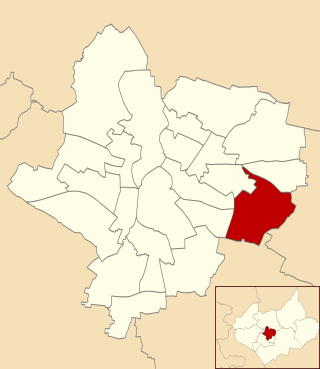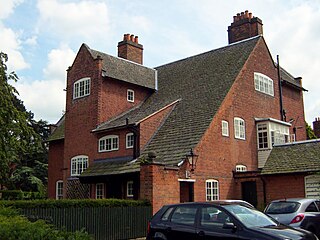
Evington is an area of Leicester, and electoral ward of the Leicester district, in the ceremonial county of Leicestershire, England. It used to be a small village centred on Main Street and the Anglican church of St Denys but was close enough to Leicester to become one of the outer suburbs in the 1930s. Today, the ward comprises the historical village of Evington, as well as the modern ex-council estates of Rowlatts Hill and Goodwood. The population of the ward at the 2011 census was 11,133.

Whittington Hospital is a district general and teaching hospital of UCL Medical School and Middlesex University School of Health and Social Sciences. Located in Upper Holloway, it is managed by Whittington Health NHS Trust, operating as Whittington Health, an integrated care organisation providing hospital and community health services in the north London boroughs of Islington and Haringey. Its Jenner Building, a former smallpox hospital, is a Grade II listed building.

Stoneygate is part of the City of Leicester, England.

Glenfield Hospital, formally known as Glenfield General Hospital, is situated near Glenfield, on the outskirts of Leicester. It is one of England's main hospitals for coronary care and respiratory diseases. It is a tertiary referral university teaching hospital, with a strong international reputation for medical research in cardiac and respiratory health. It is managed by the University Hospitals of Leicester NHS Trust.

The Countess of Chester Hospital is the main NHS hospital for the English city of Chester and the surrounding area. It currently has 625 beds, general medical departments and a 24-hour accident and emergency unit. It is managed by the Countess of Chester Hospital NHS Foundation Trust, one of the first Foundation Trusts in the UK, formed in 2004. Cardiac rehabilitation services at the hospital are provided by Cheshire and Wirral Partnership NHS Foundation Trust.

The Leicester Royal Infirmary (LRI) is a National Health Service hospital in Leicester, England. It is located to the south-west of the city centre. It has an accident and emergency department and is managed by of the University Hospitals of Leicester NHS Trust.

Southmead Hospital is a large public National Health Service hospital, situated in the area of Southmead, though in Horfield ward, in the northern suburbs of Bristol, England. It is part of the North Bristol NHS Trust. The 800-bed Brunel Building opened in May 2014, to provide services, which transferred from Frenchay Hospital in advance of its closure. The hospital site covers 60 acres (24 ha).

The Bristol Royal Infirmary, also known as the BRI, is a large teaching hospital in the centre of Bristol, England. It has links with the nearby University of Bristol and the Faculty of Health and Social Care at the University of the West of England, also in Bristol.

North Manchester General Hospital (NMGH) is a large NHS hospital in Crumpsall, North Manchester, England. It is operated by Manchester University NHS Foundation Trust. There is an accident and emergency unit, together with a maternity unit, high dependency unit and a mental health wing. A plan to rebuild the hospital was announced by Boris Johnson in the 2019 General Election campaign, and in November 2020 a £54 million funding bid for improvement works was made by the Trust, Manchester City Council, and Manchester Health and Care Commissioning.

The Royal South Hants Hospital, known locally as "The RSH", is a community hospital in Southampton. It is managed by NHS Property Services.

Croydon University Hospital, known from 1923 to 2002 as Mayday Hospital and from 2002 to 2010 as Croydon Hospital, is a large NHS hospital in Thornton Heath in south London, England run by Croydon Health Services NHS Trust. It is a District General Hospital with a 24-hour Accident and Emergency department. The hospital is based on a 19-acre (7.7 ha) site in Thornton Heath to the north of central Croydon.

University Hospitals of Leicester NHS Trust was created in April 2000 with the merger of the Leicester General Hospital, Glenfield Hospital and Leicester Royal Infirmary.

The University Hospital of South Manchester NHS Foundation Trust is a defunct NHS foundation trust that previously operated Wythenshawe Hospital, a major acute teaching hospital in Wythenshawe, Manchester. Many of the services and facilities previously at Withington Hospital were transferred to Wythenshawe in 2004. It provided services for adults and children at Wythenshawe Hospital and Withington Community Hospital. It runs Buccleuch Lodge Intermediate Care Unit and the Dermot Murphy Centre in Withington, and the Specialised Ability Centre in Sharston.

University Hospital Lewisham is a teaching hospital run by Lewisham and Greenwich NHS Trust and serving the London Borough of Lewisham. It is now affiliated with King's College London and forms part of the King's Health Partners academic health science centre. It is situated on Lewisham High Street between Lewisham and Catford.
Leicestershire Partnership NHS Trust provides mental health, learning disability and community health services across Leicestershire, England.
Healthcare in Cumbria was the responsibility of Cumbria Clinical Commissioning Group until July 2022. On 1 April 2017 32 GP practices left the CCG and merged with Lancashire North CCG to form Morecambe Bay CCG.

Brighton General Hospital is an acute general hospital on Elm Grove in Brighton, East Sussex. It is managed by Sussex Community NHS Trust. The main Arundel building is Grade II listed.
Healthcare in Leicestershire was the responsibility of three clinical commissioning groups covering West Leicestershire, Leicester City and East Leicestershire and Rutland until July 2022. As far as the NHS is concerned Rutland is generally treated as part of Leicestershire.

Stamford and Rutland Hospital is an elective care hospital in Stamford, Lincolnshire administered by North West Anglia NHS Foundation Trust.
The Northern Care Alliance NHS Foundation Trust (NCA) is an NHS foundation trust in Greater Manchester, England.
















